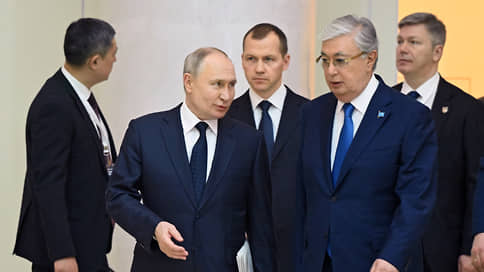The presidents of the EAEU countries held this year’s final meeting
[ad_1]

The presidents of the countries of the Eurasian Economic Union (EAEU) gathered in St. Petersburg for this year’s final summit. It ended with the signing of a long-term program document – the Declaration on the development of the association until 2045 “Eurasian Economic Path”. In addition, the heads of the five countries signed an agreement on the creation of a full-scale free trade zone of the EAEU with Iran and summed up preliminary economic results for 2023, noting the current GDP growth in all states of the union in the range from 3% to 9%.
The final meeting of the Supreme Eurasian Economic Council was held in St. Petersburg on December 25. Before embarking on his agenda, the presidents of the five countries held a ceremony for signing a full-scale agreement on a free trade zone between the EAEU and Iran (see “Kommersant” dated December 22). Now the agreement must be ratified by parliaments to enter into force.
Speaking about the preliminary results of 2023, Vladimir Putin noted that economic growth was recorded in all EAEU countries: in Russia over three quarters it amounted to 3%, in Armenia – more than 9%, in Kazakhstan – almost 5%, in Kyrgyzstan – more than 4% , and in Belarus – 3.5%.
Industrial production in the EAEU, the Russian president added, increased by 3.5%, the construction industry grew by 9.3%.
Speaking about the prospects, Kassym-Jomart Tokayev called for “jointly preparing for the challenges of 2024” – according to him, in connection with forecasts that the global economy will grow at a modest pace from 1.5% to 3%, the EAEU, being an integral part The global economy “may also experience this slowdown.”
In addition to the agreement with Iran, another important and long-prepared document was the Declaration on the further development of the EAEU until 2030 and for the period until 2045 – the “Eurasian Economic Path”.
As Kazakh President Kassym-Jomart Tokayev explained, this program is associated with the well-known Chinese “One Belt, One Road” initiative. Vladimir Putin noted that the declaration reflects the vision of the five countries of the union on how Eurasian integration should further develop.
The Eurasian Economic Commission (EEC) reported that the declaration contains six directions: the provision of a common market with key goods and resources (and its effective functioning), the formation of a common space for cooperative interaction in the field of technological development, the creation of a common transport and logistics space and a common financial market , the development of economic cooperation in areas that have “integration potential,” as well as the functioning of the EAEU “as a pole of economic attraction in the international arena.”
Next, the EEC will have to develop and submit for approval in 2025 a draft “road map” for the implementation of the adopted declaration. Before that, a number of unresolved issues need to be resolved. Prime Minister of Armenia Nikol Pashinyan noted among them “the achievement of fundamental decisions” to harmonize the principles and mechanisms for the functioning of common energy markets. Kyrgyz President Sadyr Japarov believes that when developing the road map, it is important to “carefully approach” ensuring the freedom of movement of goods, labor, services and capital – in particular, to eliminate all regulatory gaps and opportunities for hidden types of control. In his opinion, the full implementation of a system for tracking the movement of goods as they move within the union and the speedy creation of an integrated information system for data transmission using an electronic digital signature will help the development of trade.
The leadership of the EAEU countries regularly speaks about obstacles to more effective integration – for example, Kassym-Jomart Tokayev said that, despite the opening of customs borders, each country continues to de facto protect its producers from competition with other EAEU members.
In this regard, he added, it is necessary to remove barriers and restrictions in the common market. They are removing barriers in the EAEU, however, on a permanent basis. According to the EEC, in 2022–2023 alone, 15 barriers, 10 obstacles with signs of barriers, 3 restrictions and 2 exemptions were removed. Currently, there are 34 more obstacles in the register, of which 18 are planned to be eliminated by 2025.
Let us note that at the meeting in St. Petersburg, a significant personnel decision was made – as part of the rotation, Mikhail Myasnikovich was replaced as head of the EEC by the former Prime Minister of Kazakhstan, EEC Minister for Finance Bakytzhan Sagintayev.
[ad_2]
Source link






